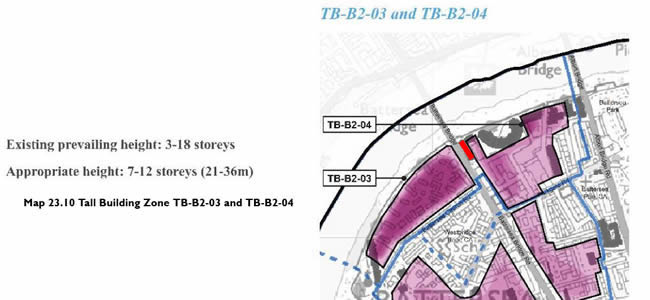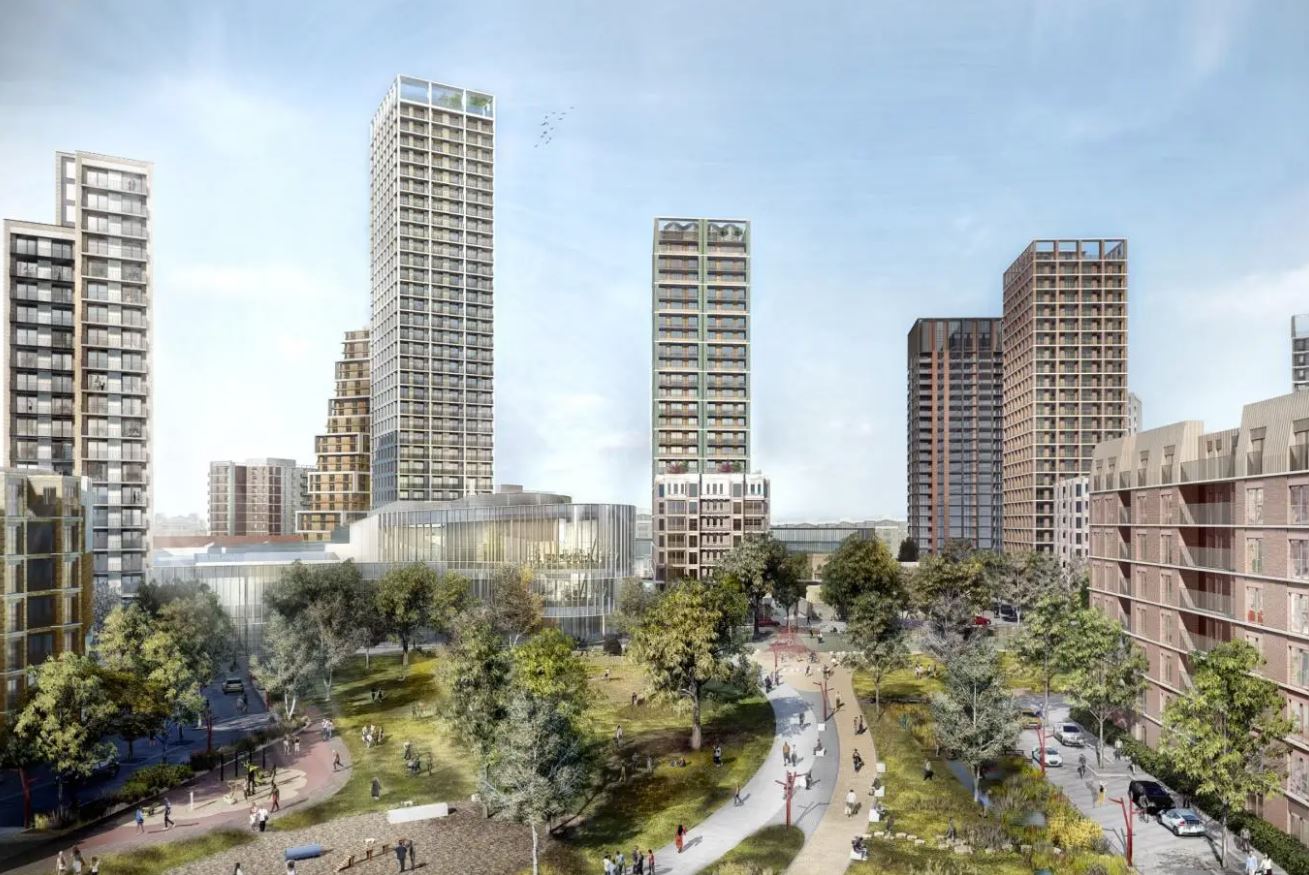On Thursday 24 April, the Planning Application Committee voted unanimously to reject Rockwell’s proposal for a 29-storey tower at Battersea Bridge. However, the decision raises questions about the weight given to statutory planning policies, which seem increasingly vulnerable to political expediency and shifting local circumstances.
The scheme (p.a. 2024/1322) aimed to replace the current glass-clad building on the southern bank of the river, situated at the base of Battersea Bridge. It was the third iteration of a plan originally submitted to the Council in January 2024 with 38 storeys, then reduced to 33/34 storeys in May 2024, and eventually amended in October 2024 with the final dimensions.
The proposed building had been scaled back to officially 28 storeys plus ground floor and basement (effectively 29-30 storeys in total). The lower section of the building increased by one floor to 11/12 floors (including ground level), but the most significant change was the proposal to provide 50% affordable housing, all as low-rent flats—a substantial increase from the initial proposal of 35% affordable units.
- Read about the 33-storey application: The huge tower for Battersea Bridge is now an official planning application
- Read also previously: 38-storeys tower proposal in Battersea Bridge: Are people told they are wasting their time in consultation?
The total number of units was reduced to 110 dwellings from the original 142, with 54 designated as social homes.s.
The boost of low rent units in the proposal was made possible thanks to a new grant offered by the Mayor of London for houses schemes where at least 40% of the homes are affordable. It is a “game changer” claimed Nicolas Mee, managing director of development at Rockwell (the company behind the proposal). “In eligible schemes, the developer, in partnership with a housing association, is expected to fund the first 20 per cent of affordable homes, then the GLA pays £170,000 for every additional social home they build above that“, he explained in an article published in The Times’ property section.
In simple words, London taxpayers are funding most of the social homes built after the initial 20% required for the developers, to compensate for the developers not being able to sell a larger part of their units as luxury flats.

From the start, the developers knew they were driving a coach and horses through the local planning rules
Wandsworth Local Plan and Policies Map was adopted on 19 July 2023 after three years of consultation. The statutory policies explicitly address building height considerations in relation to surrounding structures (Tall Building Policy LP4, p294, section 7):
“The massing of any proposed tall buildings should be proportionate to the local environment […] and should be designed so as not to create an overbearing impact having regard to its context.”
The architect was aware that the proposal contradicts the local plan, he said to CJI at the public exhibition on October 12th. However, he was quick to highlight a potential loophole in the wording: the local plan does not “explicitly” prohibit tall buildings at this location. He stated that while Tall Building policy-C says that “The Council will seek to restrict proposals for tall buildings outside the identified tall building zones“, it does not explicitly forbid them.
Nevertheless, as acknowledged by the developers, the policy remains an issue for them as it says in its previous paragraph (LP4-B):
“Proposals for tall buildings will only be appropriate in tall building zones identified on tall building maps”
This is written in future tense, not conditional. The site lies outside the designated Tall Building zone and should therefore comply with the ‘mid-rise’ category, defined as a maximum of 6 storeys or 18m (whichever is lower).

The importance of respecting the surrounding environment had already been acknowledged by earlier developments. When Foster & Partners designed the neighbouring Albion Riverside complex — the distinctive, banana-shaped building with its aluminium frontage — they explicitly recognised the area’s height constraints:
“The principal building on the waterfront is eleven storeys high. Its massing is designed to respect the heights of neighbouring buildings and to frame the view of the river from the opposite bank.”
Massive opposition from local residents on both sides of the bridge

The opposition to the tower has been overwhelming, as illustrated by the number of objection received by the Council: a record-breaking of 2005 objections, alongside a striking 1,892 expressions of support..
On this latest figure, serious concerns have been raised over the validity of the support, with many letters featuring identical wording with only minor changes to sender details, suggesting a coordinated campaign by the developer. The consultation process itself was criticised as misleading. Conservative Councillor Caroline de La Soujeole (St Mary’s ward) explained:
“The question asked was : do you support affordable housing, without giving the context of the actual scheme. And that’s why they got so many letters because in principal most people would agree we need more affordable housing.”
A local objector’s website campaigned against the proposal, and the Stop One Battersea Bridge (SOBB) petition garnered more than 5000 signatures. The initiative, launched by journalist Rob McGibbon who lives in Chelsea near the proposed tower site (and edits The Chelsea Citizen online newspaper), attracted widespread publicity and support from celebrities including Sir Mick Jagger, Eric Clapton, Felicity Kendal, Anthea Turner, Harry Hill and Lord Browne of Madingley.
Following the Planning committee meeting that led to the refusal, McGibbon said:
“This planning application had more flaws than floors and I am delighted that the council saw through it. This was a vote for common sense and for people power.
The committee meeting was full of damning statements from councillors about Rockwell’s plan and they laid bare all the problems that it would have caused. I hope that the company now scraps the scheme altogether and that they do not appeal. This was the wrong scheme, in the wrong area, and they took on the wrong community.”

“Just because an architect’s computer software says that a tower can be built on a piece of land, it does not make it sensible, viable or morally right. My sincere thanks goes to everyone who supported my campaign,” he added.
As expected, Rockwell’s managing director, Nicholas Mee, criticised the council for making the “wrong call“, according to South London Press.
Wandsworth’s decision should not come as a surprise, as developers appeared to anticipate rejection during public exhibitions last year. The architect revealed that ultimately, the Mayor of London’s views would be most important to them, and they were already planning their next steps, possibly an examination by the Greater London Authority (GLA).
With Sadiq Khan desperate to meet his targets on affordable housing, they seem to bet that their new provision of 50% social housing will get approval. During our discussion, they insisted that with 11,000 local people on its housing waiting list and with the so-called housing shortage that the Mayor of London is addressing, they seem confident to get approval despite the local context.
Rockwell has not yet announced its next steps, though the developer has not abandoned the scheme yet—perhaps because they have already paid at least £1.75 million deposit to secure the site (alongside consulting and pre-application costs), as part of a total of £45 millions payable if planning permission is obtained.
Both officers and councillors agreed that the proposal was inappropriate
The rejection of the proposal was unanimous among members of Wandsworth Planning committee.
In reaching their decision, Councillors were guided by the work of Wandsworth Council officers, who prepared a highly detailed 132-page report recommending rejection of the scheme. In their conclusions, officers stated:
“The harm identified is at such odds with these policy objectives [the criteria of the London Plan D9 and the Local Plan PM9 and LP4] that are contained with a young Local Plan adopted in 2023”
The officer’s report cited a recent appeal decision by the Planning Inspectorate for a 34-storey tower in the borough of Newham, noting that the Inspector concluded that flexibility and planning balance “does not mean development at any price or any height of tower would be acceptable, nor does it annul the design emphasis in the NPPF” (National Planning Policy Framework).
The report added that “the proposal, due to its excessive and dominent height, is not sympathetic to the local character of the area, nor the surrounding built environment which is predominantly six storeys in height” and that a development should be refused “where it fails to reflect local design policies“.
This led to a series of statements from Councillors highlighting the proposal’s inadequacy. Cllr de La Soujeole presented residents’ views, saying:
“The proposal goes against so many of the Council’s local plan policies, as well as the London Plan policies and the NPPF, it makes a total mockery of the Council’s policies if you vote for this application”
Written comments from Labour Cllrs Jamie Colclough and Jessica Lee stated:
“Our residents think it’s important to send a loud and clear message to developers schemes like this that ignore the local character and put profit ahead of improvements to the local area and people’s well-being just aren’t welcome here in Battersea”
Labour Cllr Finna Ayres was particularly blunt:
“I think the problem with this is that it’s not just too big, it’s not just too tall; it’s so enormous it’s almost a joke. I can hardly believe it’s a serious application”
The comparison with the Gasworks scheme approved last month
Most councillors’ comments about the Battersea Bridge tower proposal echoed those made during last month’s committee meeting regarding the Gasworks proposal—a scheme featuring buildings up to 29 storeys tall in an area where planning guidelines limit heights to 7-10 storeys.
Similar arguments were presented for both developments, yet with starkly different outcomes—the Council approved the Gasworks scheme but rejected the Battersea Bridge tower.
During the previous meeting, Cllr Ayres said:
“Quite seriously the only thing that makes me shut my eyes to the 29 story block and all these other problems I’ve mentioned are the public housing provision.”
- Read our article: Gasworks site: “It’s a joke! I understand how the public lose faith in the Council”
Cllrs Jamie Colclough and Jessica Lee insisted (in a written statement) “this is a very different application to the Gasworks one,” while Cllr Apps claimed “the context couldn’t be more different now as the development is right next to existing buildings.” Labour councillor White added that “in the context of the Gasworks site, developers could reference lots of different buildings very very high in that area; we are talking here about an area where it’s not the case at all.”

Despite the denegation of Labour councillors, the two schemes shared significant similarities.
Both proposals were in clear breach of planning policies: the recently adopted Local Plan set a maximum height of 7 to 10 storeys for the Gasworks zone, yet councillors approved buildings ranging from 10 to 29 storeys. For the Battersea Bridge site, developers put forward elements of 28/29 storeys with an 11/12-storey section, even though local policy specifies a six-storey maximum
Glassmill offered 50% social housing while the Gasworks development proposed 40% (not 50% as some councillors said during the meeting) affordable housing with 70% being low rent. Even more favourably for Glassmill, according to calculations by Wandsworth’s viability assessment team, the Battersea Bridge application might have been financially positive, while the Gasworks site was likely to present a significant financial deficit (and Cllr White noted at the time that they have “every reason to be worried about this“… before voting in favour of the scheme).
Nevertheless, the Gasworks was approved, while Glassmill was rejected.
Inconsistent Council decisions could lead to fatal consequences for planning
Conservative councillor Guy Humphries, former chair of the committee, summarised the key issue:
“Again it’s that message that it sends out to developers […] it isn’t altogether surprising when developers come up within a proposal like this which is so extraordinary that out of context because they think our local plan doesn’t evidently mean much.”
By approving the Gasworks development while rejecting the Glassmill proposal, the Council has created a precedent that suggests planning policies can be selectively applied or disregarded based on unspecified criteria.
Council Leader Simon Hogg’s statement about the Glassmill rejection highlights this contradiction. He said:
“The committee were unanimous about the harms of a 29-storey tower in this location, in breach of Wandsworth’s Local Plan which sets out acceptable heights for the area.”
Yet the Gasworks development, similarly breaching height restrictions, received approval.




















